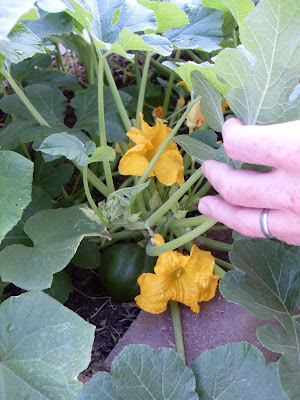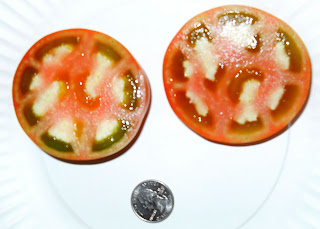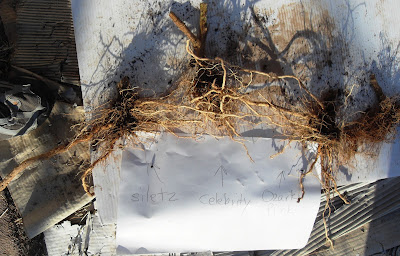In order to remain self-sufficient, many gardeners choose to save seed from their favorite fruit and vegetable varieties. When seeking to save seed properly, it is important to know what you are doing. A seed saver needs to know how to grow a plant, how the plant pollinates, how to save seed, and other factors that may affect future seed viability including plant selection, variety isolation and inbreeding depression.
I began researching inbreeding depression in order to help me better determine how to plant my garden in the future. I recently read about it in The Heirloom Life Gardener by Baker Creek seeds and in The Resilient Gardener by Carol Deppe. Inbreeding depression occurs when plants have too small of a population of fellow breeders during pollination. It causes future generations of plants to be weak as demonstrated by slow growth, poor vigor and disease resistance, along with poor fruit production. Some varieties of plants such as tomatoes, which can self-pollinate, have a much smaller problem with inbreeding depression than plants such as corn, that require a population of at least 200 plants to keep from inbreeding depression.
In The Resilient Gardener, Carol Deppe says the following about inbreeding depression for corn: “Corn is very subject to inbreeding depression. Here’s an illustration: Suppose you grow up a hundred plants and save grain each year from the plant that yields best. What kind of yield will you have in five years? Answer: Your corn variety will be so weak, wimpy, and low-yielding that you will be lucky to be able to keep it going at all. Its yield will stink compared to what you have started with, even though you selected for the highest yield each year.” pg. 282
Carol Deppe goes on to explain some standards to live by to keep from inbreeding: “The standard seed-saving rule of thumb is to save seeds from 20 plants if the species is an inbreeder and from 100 or more plants if it is an outbreeder”. Pg. 304
So what is an inbreeder? An inbreeder is a kind of plant that can pollinate its own flower if needed. Each flower contains all parts needed for pollination and fruiting. Tomatoes, peppers, eggplant, peas, and beans are good examples of inbreeders. Though cross-pollination may not happen too often, it is important to grow a large enough population on inbreeders that if a detrimental trait arises you can select out the bad plants and keep only the best plants out of the population.
An outbreeder is a plant that has separate pollen-producing and pollen-receiving structures within the plant. Outbreeders include the cucurbit family, many grains, melons, and most other garden plants.
Each vegetable variety has various tolerance to inbreeding depression but it is good to follow the 20/100 rule to keep from having long-run problems with your seed. That is with exception of the maize family, which requires 200 plants to keep from exhibiting inbreeding depression.
Having to select the best plants from each population and having to make sure there is a large enough population to keep from inbreeding depression can be reason to cause depression among many home gardeners. So what can a gardener do to make sure that inbreeding depression does not happen? A gardener could make sure that he grows enough of a crop each year, or he could save seed from multiple years while using different seed each year, or he could grow the same variety with other gardeners and swap seeds to keep genetic diversity high. The last option assumes that both gardeners are selecting seed for attributes that both have determined are the most important. Another helpful practice for gardeners saving seed would be to mark what year or batch the seed was grown in and note how many plants were in the population that produced the seed.
Some other websites that are really helpful in understanding inbreeding depression include Seed Saver's Exchange Seed Saving Chart. For seed saving, gardeners should at least grow enough plants to maintain a variety. There is also a website that tells about those crops that are most tolerant and sensitive to inbreeding depression.
 |
| This Acorn Squash is a good example of an outbreeder |
I began researching inbreeding depression in order to help me better determine how to plant my garden in the future. I recently read about it in The Heirloom Life Gardener by Baker Creek seeds and in The Resilient Gardener by Carol Deppe. Inbreeding depression occurs when plants have too small of a population of fellow breeders during pollination. It causes future generations of plants to be weak as demonstrated by slow growth, poor vigor and disease resistance, along with poor fruit production. Some varieties of plants such as tomatoes, which can self-pollinate, have a much smaller problem with inbreeding depression than plants such as corn, that require a population of at least 200 plants to keep from inbreeding depression.
In The Resilient Gardener, Carol Deppe says the following about inbreeding depression for corn: “Corn is very subject to inbreeding depression. Here’s an illustration: Suppose you grow up a hundred plants and save grain each year from the plant that yields best. What kind of yield will you have in five years? Answer: Your corn variety will be so weak, wimpy, and low-yielding that you will be lucky to be able to keep it going at all. Its yield will stink compared to what you have started with, even though you selected for the highest yield each year.” pg. 282
Carol Deppe goes on to explain some standards to live by to keep from inbreeding: “The standard seed-saving rule of thumb is to save seeds from 20 plants if the species is an inbreeder and from 100 or more plants if it is an outbreeder”. Pg. 304
So what is an inbreeder? An inbreeder is a kind of plant that can pollinate its own flower if needed. Each flower contains all parts needed for pollination and fruiting. Tomatoes, peppers, eggplant, peas, and beans are good examples of inbreeders. Though cross-pollination may not happen too often, it is important to grow a large enough population on inbreeders that if a detrimental trait arises you can select out the bad plants and keep only the best plants out of the population.
An outbreeder is a plant that has separate pollen-producing and pollen-receiving structures within the plant. Outbreeders include the cucurbit family, many grains, melons, and most other garden plants.
Each vegetable variety has various tolerance to inbreeding depression but it is good to follow the 20/100 rule to keep from having long-run problems with your seed. That is with exception of the maize family, which requires 200 plants to keep from exhibiting inbreeding depression.
Having to select the best plants from each population and having to make sure there is a large enough population to keep from inbreeding depression can be reason to cause depression among many home gardeners. So what can a gardener do to make sure that inbreeding depression does not happen? A gardener could make sure that he grows enough of a crop each year, or he could save seed from multiple years while using different seed each year, or he could grow the same variety with other gardeners and swap seeds to keep genetic diversity high. The last option assumes that both gardeners are selecting seed for attributes that both have determined are the most important. Another helpful practice for gardeners saving seed would be to mark what year or batch the seed was grown in and note how many plants were in the population that produced the seed.
Some other websites that are really helpful in understanding inbreeding depression include Seed Saver's Exchange Seed Saving Chart. For seed saving, gardeners should at least grow enough plants to maintain a variety. There is also a website that tells about those crops that are most tolerant and sensitive to inbreeding depression.








